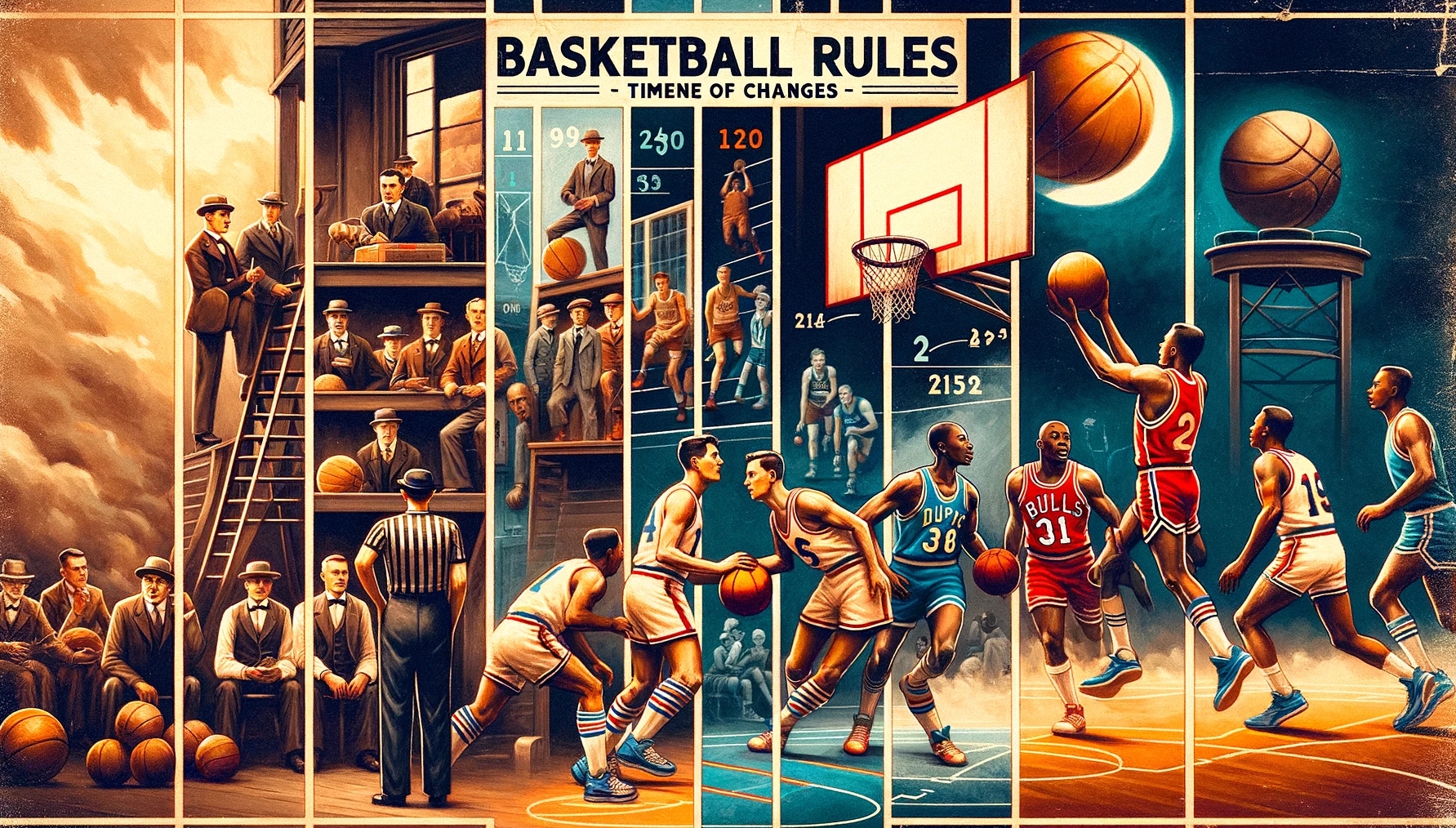Basketball, a sport that began in the late 19th century as a simple game with a ball and a peach basket, has evolved into a global phenomenon with millions of followers. Over the decades, as the game grew in popularity and expanded its reach, its rules underwent significant transformations to accommodate the changing dynamics of play, players’ skills, and fan preferences. The NBA, representing the pinnacle of professional basketball in the USA, and FIBA, the global governing body for the sport, have been at the forefront of these changes. In this article, we journey through a timeline that traces the pivotal rule changes in both the NBA and FIBA, providing readers with a comprehensive view of basketball’s evolving rulebook. Whether you’re a basketball enthusiast keen on understanding the basic rules and nuances of your favorite sport or a curious reader looking to delve into the history of the game by checking out original rules of Jan. 15, 1892, this timeline offers insights into how basketball has shaped and been shaped by its rules.
NBA Rules – Timeline of Changes
1946-1950s: Foundations & Adjustments
- 1946: The Basketball Association of America (BAA), a precursor to the NBA, was established.
- 1949: The BAA merged with the National Basketball League (NBL) to form the NBA. The shot clock was not in place, so games were much slower-paced.
- 1954: The 24-second shot clock was introduced to prevent teams from stalling. This dramatically increased the pace and scoring of games.
1960s: Expansion and Refinements
- 1964-65: The NBA adopted the rule that a free throw shooter couldn’t cross the free throw line until the ball hit the rim.
- 1966: The league expanded from 9 teams to 10 and adopted an 81-game schedule.
- 1967: Dunking was banned during warm-ups to prevent basket interference.
1970s: Major Evolution & Integration
- 1972: The NBA adopted the rule that a player would be disqualified on his sixth personal foul, rather than his fifth.
- 1976: The NBA and ABA (American Basketball Association) merged, bringing four new teams into the league. The ABA introduced the three-point line, which was adopted by the NBA in the subsequent seasons.
- 1979: The NBA officially adopted the three-point line.
1980s: Showtime Era & Defensive Rules
- 1981: The NBA introduced a pair of free throws (instead of one free throw and possession of the ball) for each common foul (except offensive fouls) committed by a team over the limit.
- 1984: The league expanded its playoff field to 16 teams.
- 1988: The NBA instituted the five-foul disqualification for individual players in overtime periods.
1990s: Growth & Global Influence
- 1994: The league shortened the three-point line from 23 feet, 9 inches to 22 feet.
- 1997: Hand-checking on the perimeter was more strictly enforced, promoting more freedom of movement for offensive players.
- 1999: The three-point line was moved back to its original distance.
2000s: Modern Adjustments & Technology
- 2001: The NBA adopted the “no-charge” semi-circle area under the basket, where defenders cannot take a charge.
- 2002: The NBA eliminated the illegal defense rule, allowing zone defenses. This fundamentally changed team defensive strategies.
- 2004: A rule was introduced to curtail hand-checking on the perimeter, allowing perimeter players more freedom to drive to the basket.
2010s: Pace & Space Era
- 2013: The league clarified its “verticality” rule, allowing defenders to jump vertically when defending, even if they’re in the path of an offensive player.
- 2016: The “Hack-a-Shaq” strategy (intentionally fouling a poor free throw shooter) was discouraged with rule changes. Teams now receive one free throw and retain possession if the tactic is used in the last two minutes of each quarter.
- 2019: Coaches were given the ability to challenge one call per game, marking a significant shift towards incorporating technology and reviews into the officiating process.
2020s: Adapting to Modern Play
- 2020: The NBA introduced a new “Coach’s Challenge” system, where each coach could challenge one on-court call per game.
- 2021: In an effort to improve game flow, the NBA reduced the number of team timeouts in a game. The league also continued to make tweaks to deter “flop” attempts by players seeking fouls.
This timeline showcases just a selection of key rule changes and modifications in the NBA’s history, reflecting the league’s constant evolution in response to both the skill level of its players and the desires of its fan base.
FIBA Rules – Timeline of Changes
1950s: Formation & Early Adjustments
- 1950: FIBA (International Basketball Federation) organized its first World Championship for men.
- 1953: FIBA introduced the rule of allowing players five personal fouls before disqualification.
1960s: Expansion and Clarifications
- 1967: FIBA clarified rules surrounding traveling, specifically when players could start and stop their dribble.
1970s: Global Growth & Structural Changes
- 1976: Basketball, under FIBA’s rules, made its debut at the Olympics for women.
- 1978: FIBA officially moved from a half-court game to a full-court game format, modernizing the sport and bringing it more in line with the style played in professional leagues worldwide.
1980s: Aligning with Modern Basketball
- 1984: FIBA allowed the slam dunk, which had previously been illegal.
1990s: Modern Adjustments & Professional Players
- 1992: FIBA rules were amended to allow professional basketball players to participate in the Olympics, ushering in the era of the “Dream Team” from the USA.
- 1994: FIBA introduced the 14-second shot clock reset after an offensive rebound.
2000s: Embracing the Global Game
- 2008: FIBA changed its key (the paint area) from a trapezoidal shape to a rectangular one, making it more consistent with the NBA.
- 2010: FIBA moved the three-point line from 6.25 meters to 6.75 meters.
- 2012: FIBA adjusted its traveling rule to be more in line with the NBA, allowing players to take a step before starting their dribble.
2010s: Enhancements & Safety
- 2014: FIBA implemented a rule that any unsportsmanlike foul in the last two minutes of a game or in overtime would result in two free throws and possession of the ball.
- 2017: FIBA adjusted the rule regarding technical fouls. A single technical foul would result in one free throw for the opposing team.
- 2018: FIBA introduced the new “traveling” rule to offer clarity and to be in line with the way the game is played globally.
2020s: Adjusting to Modern Play
- 2020: FIBA made changes to align more closely with the NBA’s rules regarding “gather steps,” offering players more flexibility when driving to the basket.
- 2021: Adjustments were made to the unsportsmanlike foul rules to ensure clearer and more consistent calls.
Throughout its history, FIBA has continuously adapted its rules to reflect the changing nature of global basketball, taking cues from both its own internal competitions and the styles of play evident in professional leagues around the world.
Basketball’s journey, as illustrated by these timelines, is a testament to the sport’s adaptability and enduring appeal. From foundational shifts to nuanced tweaks, each change in the rule-book has been a reflection of the game’s evolution and the ever-changing dynamics of play. Both the NBA and FIBA, in their respective spheres, have been instrumental in shaping the game we know and love today. These changes, driven by a combination of innovation, player safety, and the desire to maintain the game’s competitive balance, have ensured that basketball remains thrilling, unpredictable, and universally beloved. As we look to the future, one can only anticipate the exciting developments yet to come in the world of basketball. The game’s history suggests that, regardless of the changes ahead, the essence of basketball—teamwork, strategy, and sheer athleticism—will always remain at its heart.

